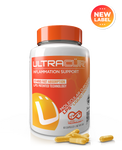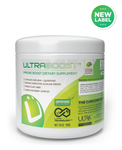
In recent years, scientific research has been ablaze with new discoveries about aging, why some people age faster than others, and the role that “zombie cells” called senescent cells play in rapid aging.
Life expectancy has risen dramatically over the past few decades. But this longer lifespan has not equated with increased healthspan. Instead, it has left a long trail of diseases linked to aging.
Now, more and more scientific studies have zeroed in on cell senescence as a major contributor to the development of age-related diseases – which include heart disease, strokes, diabetes, arthritis, and many more.
So what is cell senescence, anyway? And what do we know so far about getting rid of senescent cells?

Cell Senescence Defined
More than 60 years ago in 1961, two researchers (Hayflick and Moorhead) studied to find out if human cells could be replicated indefinitely in a lab dish. Interestingly, they found that cultured human cells fail to replicate forever but instead begin to slow cellular division and become dormant.
This slowdown is called senescence. The term “senescence” comes from the Latin term “Senex,” which means “old man.”
Unfortunately, senescent cells don’t die off. They hang around. In fact, they actively resist cell death by upregulating pathways critical to their survival.
What’s more, they start to do weird things, like changing their shape and size... and secreting inflammatory molecules, which in turn cause more cells to become senescent.

Causes of Senescence
When cells hit a critical point where they can no longer withstand additional damage or stress, senescence is triggered. This helps keep the integrity of the cell’s genetic blueprint, its DNA, intact.
Cellular damage and stress can come from external sources including toxins, viruses, or radiation. It can include X-rays, air pollution, toxins in cleaning and beauty products, and more.
Internal stress can also damage cells... including naturally occurring everyday cellular processes.
Even your metabolism – how your cells convert food into energy – can generate DNA-damaging molecules called reactive oxygen species (ROS). When you amass too many ROS for your body to detoxify, it creates a state of oxidative stress, which makes your DNA highly susceptible to damage.
Another cause of internal stress is the one discovered by Hayflick and Moorhead... limits to our cell replication.
Your chromosomes – the long DNA strands – have protective end caps of repetitive DNA called telomeres. Every time they replicate, the ends get trimmed. These caps are only so long, and therefore can only protect from a certain number of cell replications.
When our telomeres get whittled away to a certain level, DNA damage occurs, pushing cells into senescence so they stop replicating.
Senescence seems to be closely related to what and how much we eat. Scientists believe that over-eating can trigger senescence... concluding this because fat tissue from obese mice are littered with senescent cells.
In addition, obese individuals show increased ROS production in fat tissue.
In summary, senescent cells can come from over-consumption of food (especially processed food), ROS, telomere shortening, DNA damage, and metabolic stress... or any combination of these.

Senescent Cells and Rapid Aging
There’s a well-established link between aging and senescence. As we age, we are exposed to increasing thresholds of stress, which leads to an increase in senescent cells. But how do senescent cells actually affect aging?
Many recent studies show that when researchers depleted the number of senescent cells in aging animals, it postposed the onset of age-related diseases and dramatically extended their lifespan.
These findings have ignited more clinical interest and (of course) a push to develop pharmaceutical drugs to eliminate senescent cells. It’s worth noting that most drugs start as natural compounds that drug companies then re-create in synthetic form, patent, and sell at high prices.
Fortunately, scientists have also discovered a number of natural compounds that possess the ability to reduce senescent cells. We'll discuss those in a moment. But first...

What’s the Purpose of Cellular Senescence Anyway?
Scientists believe that a major reason our cells have the ability to enter senescence is to protect us from faulty DNA replication. That could serve a critical function in preventing cancer and limiting tissue damage by stopping the reproduction of damaged cells.
Senescence also plays a positive role in early development during pregnancy and early childhood, and has been discovered in many species including humans, birds, amphibians, and fish.
Scientists think it helps fine-tune organ development. During early stages of life, senescent cells are targeted and eliminated by the immune system.

How Can We Fight Cellular Senescence?
Cellular senescence isn’t something you have no control over any more. There are means to address it:
- Natural compounds that prevent the accumulation of senescent cells
- Natural compounds that reduce pro-inflammatory molecules secreted by existing senescent cells
- Pharmaceutical therapies aimed at either of the above
Some studies show that calorie-restricted diets begun in adulthood can cut the number of senescent cells that are produced.
Calorie restriction is widely recognized to extend longevity and reduce the diseases of aging. (And who wants to live longer if it has to be with debilitating diseases?)
Pharmaceutical companies have developed therapies for use in lab animals, showing remarkable results. However, efficacy and safety for humans have not been determined.
Successful therapies that target senescent cells will allow us to treat many age-related conditions such as cancer, diabetes, immune dysfunction, neurodegeneration, strokes, pulmonary fibrosis, heart disease, osteoporosis, and impaired vision.
Several natural compounds have been studied for their anti-aging effects and ability to reduce and remove senescent cells in the body.
Stay tuned... we’ll be discussing some of these promising compounds over the next few weeks in these Saturday health emails.
In addition, we will soon be launching a new product containing several of the most promising of the bunch... a product called SenUltra™.
SenUltra™ is aimed at reducing levels of senescent cells in your body, reducing inflammation, and thereby boosting your healthspan – all via well-studied and well-tolerated natural compounds.
New Podcast!
This Cancer Recovery Story Went Viral on the Internet

Joe Tippens' cancer recovery story quickly spread to 96 countries. Join us as we discuss his story on our podcast. You won't believe the phone call he got recently from China... and the nickname assigned to his protocol over there.
From small cell lung cancer and widespread mestastesis in December of 2016 to alive and kicking in 2023, he's lived quite the testament to the idea you can recover. And he's helped countless others too.
Watch the video on YouTube now . Prefer audio only? Listen on Spotify now.



